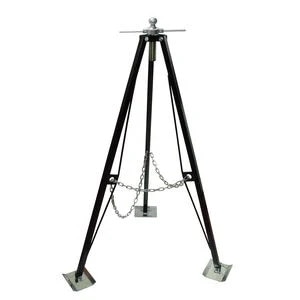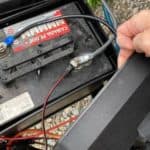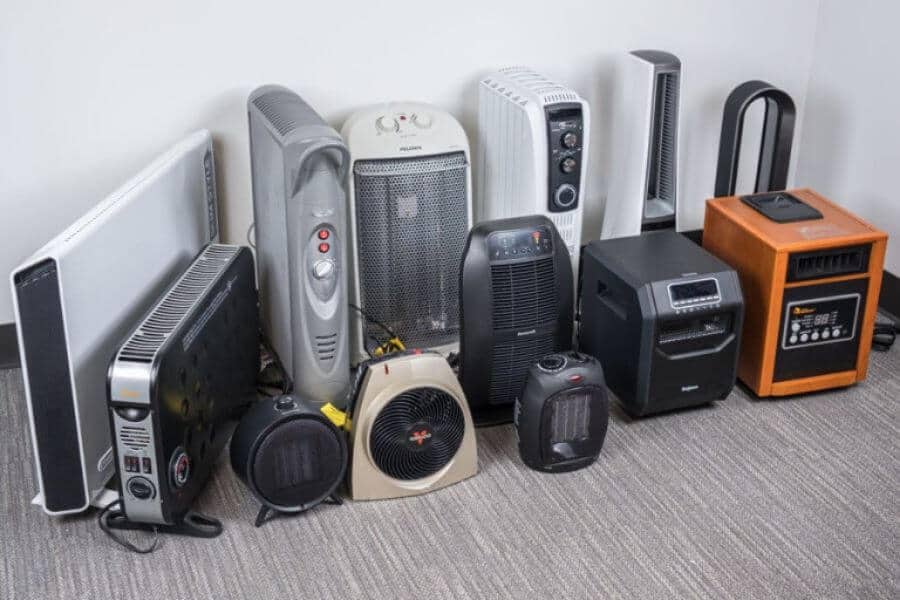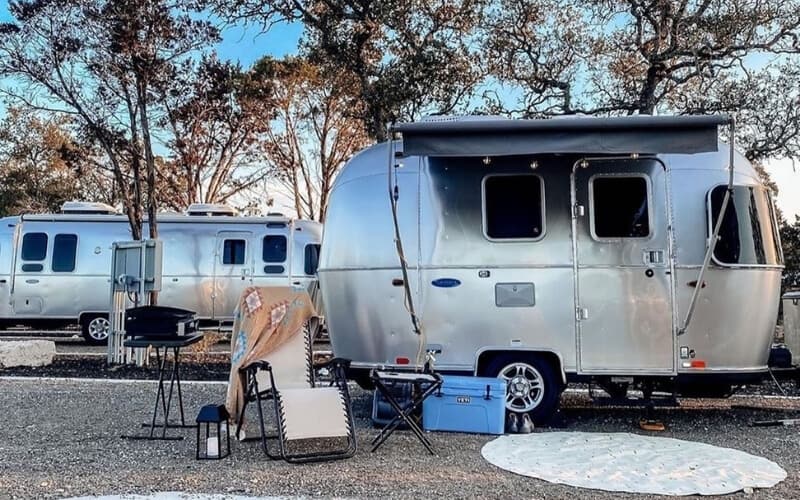The special hitch of a fifth-wheel trailer that allows it to be conveniently towed by a heavy-duty pickup truck can also leave the nosecone dangling in mid-air when you unhitch and set up camp. This can lead to an uncomfortably strange wobble when you’re living inside. Even when the hydraulic jack stands are deployed.
One of the easiest ways to counter this is to use a fifth-wheel tripod as part of your campsite setup. Proponents of this approach note that not only does it help reduce the strange wobble you get in some fifth wheels, but it also helps reduce potential wear and tear on the trailer’s frame. Especially if your fifth wheel has a front kitchen or living room that draws a lot of heavy foot traffic.
As such a simple way to protect your major investment, it seems clear that we need to take a closer look at fifth-wheel tripods and when to use them. Along the way, we’ll take a tour of some of the best fifth-wheel tripods on the market today and some potential alternatives.
What Is a Fifth Wheel Tripod?
Also known as a fifth-wheel Stabilizer, a fifth-wheel tripod stabilizer is designed to sit underneath your fifth-wheel trailer’s hitch to reduce the wobble in the nosecone area. It augments the stability provided by the hydraulic jack stands at the four corners of the trailer.
There are fifth-wheel tripods available for gooseneck and kingpin,fifth wheels.As the name implies, they have three legs that can be adjusted to different heights. It then connects to the underneath of the fifth-wheel nosecone at the hitch.
Fifth-wheel tripods effectively reduce the back-and-forth motions as well as side-to-side h rocking motion that can occur when you move around in the front area of your RV.
They also reduce the stresses caused by weight at the front of the trailer, which makes them a veritable “Must Have” accessory for fifth-wheel trailers with a front kitchen or living room.
Do You Really Need a Tripod for Your Fifth Wheel?
Technically RV manufacturers engineer modern fifth-wheel trailers to be safely self-supporting when the normal hydraulic jack stands are deployed, and the unit is properly leveled.
So, while fifth-wheel tripod aren’t an absolute necessity, they will make your trailer a lot more stable. Especially in the front nosecone area.
If you’re frustrated by the vibration, wobble, and shaking motion in the front of your fifth-wheel trailer, then it’s probably time to invest in a tripod stabilizer. They aren’t all that expensive, they’re easy to install, and might even make your camping trip more enjoyable.
Ultimately, a fifth-wheel tripod doesn’t need to be a “Must Have” accessory to make sure you have onboard before you set out on your first trip in your fifth wheel. Though, if you’re going to be camping frequently in your new trailer, you’ll certainly appreciate having it with you!
How Does A Fifth-Wheel Tripod Work?
A fifth-wheel tripod provides extra stability to a fifth wheel’s front nosecone section by minimizing the shaking, rattling, and side-to-side motion that a lot of fifth-wheel suffer from.
Most are made from three adjustable metal rods that you set up and connect to the underside of the fifthwheel’s nose section. It provides extra support for the overhang while also reducing the effective load on the front stabilizer jacks.
Benefits of a Fifth-Wheel Tripod
There are a few benefits to adding a fifth-wheel tripod that goes beyond stopping the wiggle of foot traffic in the front section of your trailer. This includes things like:
Reduced Wear & Tear
While your fifth-wheel trailer is technically engineered to bear the weight of the dangling overhang of the nose cone, a fifth-wheel tripod will further reduce the strain on the trailer’s frame. Especially if your model has a front living room or kitchen where a lot of people are in and out during the day.
A Better Night’s Sleep
A lot of couples with a front master suite in their fifth-wheel trailer find that they get a better night’s sleep with a tripod installed. If you don’t like your spouse waking you up when they roll over, you’ll love the solid stability a fifth-wheel tripod provides under your trailer’s nose cone.
Maintaining a Level Trailer
Your fifth-wheel’s jack stands are designed to help balance the load of the entire fifth-wheel when you set up camp. Still, having a fifth-wheel tripod in place when you’re set up on a soft surface, or an unpaved camper pad will help reduce the strains on the primary hydraulic jacks while helping to keep your entire trailer more level. It will also keep the feet from sinking in over the course of a long stay at one campsite.
The Downside of Using A Fifth-Wheel Tripod
There are a few minor drawbacks to investing in and using a fifth-wheel trailer every time you set up camp.
Cost
While they aren’t all that expensive, a quality fifth-wheel tripod is an additional cost that you are going to have to add to all the other accessories you need to kit out your new trailer how you want it.
Extra Setup Time
Setting up a fifth-wheel trailer at a campsite can be time-consuming as it is. When you add installing a tripod under the front overhang, you’re adding another 10 or so minutes, which can be frustrating if you just got to your campsite around sundown.
Weight & Storage Space
Fifth-wheel tripods are a little cumbersome and add weight to your rig when you’re hauling it. Even when it’s packed up, in a convenient case, it still needs to take up a fair amount of space in a premium storage compartment like your front pass-thru cargo bay.
When Do I Need To Use A Fifth-Wheel Tripod?
Fifth-wheel tripods are best for trailers that have a living space built into the front overhand. This includes models with a front kitchen or living room.
All the foot traffic of people coming and going can add a lot of shake and roll that can be annoying. Sometimes you can even feel it in other parts of the trailer!
A fifth-wheel tripod might also be a good idea for a trailer with a front master suite. Especially if one of you is a light sleeper and wakes up with the motion of your spouse rolling over or getting up to use the bathroom in the middle of the night.
The Best Fifth-Wheel Tripods in 2023
When looking for the best fifth-wheel tripods, we made sure to review models that were compatible with both kingpin-style trailers and gooseneck hitches. Along the way, we also looked for models that has a stable base, good weight capacity, and were easy to set up.
We also tried to be mindful of price, without sacrificing quality for the risk of any cut corners. This created a list of some of the most rock-solid fifth-wheel tripods your hard-earned money can buy.
1: Camco Eaz-Lift 48855 King Pin Tripod Stabilizer
Camco is a top manufacturer of tons of essential RV camping equipment. So, it only makes sense that they would bring their reputation for quality engineering to bear with this EAZ fifth-wheel tripod.
This particular model was designed to connect to a fifth-wheel trailer with a kingpin-style hitch. It’s easy to set up and lets you make major height adjustments by simply moving the adjustable foot pads either in or out.
Once you have it close to the height you want you can make minor adjustments at the screw level using the stabilizing adjusting lever, until you have it perfectly married to your fifth-wheel trailer.
This fifth-wheel tripod can accommodate an overhand height of 39 to 53-inches and has a 5,000-pound load capacity. This is more than enough to accommodate all but the heaviest of fifth-wheel trailers. It also has concave pads which help secure it in place, even on a soft surface or a paved concrete pad.
2: A-KARCK NSTJ-55 Adjustable Stabilizer Tripod Jack
This A-Karck fifth-wheel tripod is designed to work with a kingpin hitch. It has a 5,000-pound maximum weight rating, which will accommodate all but the heaviest of fifth-wheel trailers. It’s great for minimizing any bounce of rocking for a model with a front kitchen or living room.
You can adjust the height from as low as 33 inches for smaller fifth-wheel trailers to as much as 55-inches for a fifth-wheel with a towering overhang. It’s relatively easy to set up, though it doesn’t have the fine adjustment features that you find with some of the more expensive models.
You won’t notice this if you are setting up your fifth wheel on a paved concrete slab, but it might be a little more frustrating when you need to set up on a soft gravel surface. This is the tradeoff for a lower price point without compromising on weight capacity or material strength.
3: Camco Eaz-Lift 48850 Heavy Duty 7500 lb Gooseneck Stabilizer Tripod Jack
It should come as no big surprise that Camco offers another high-quality fifth-wheel tripod stabilizer for a gooseneck hitch. In truth, this is a nearly identical copy of the Camco fifth-wheel tripod we reviewed earlier for a kingpin hitch.
You get the same easy major adjustment process using the legs. Then once you have it close to the height you want you can make minor adjustments at the screw level using the stabilizing adjusting lever until you have it perfectly married to your fifth-wheel trailer.
It also has large pads which help secure it in place. However, you might want to put down some paving stones if you need to set it up on a loose surface or a tamped gravel pad.
This gooseneck tripod has a height range from 30 to 44-inches, which is in range with a log of gooseneck fifth wheels. It also has a 7,500-pound weight rating to handle some true heavy-weight trailers. Though It’s not compatible with vehicles equipped with Anderson Ultimate hitches.
4: Ultra Fab 19-950450 Steel Gooseneck Tripod jack
This Ultra Fab is another fifth-wheel tripod stabilizer that’s meant to connect to trailers with a gooseneck hitch. One of the nice things about it is that it offers a superior height range from as low as 33-inches all the way up to 55-inches.
This Ultra Fab fifth-wheel tripod has 5″ x 5. 5″ footpads that do a good job of combat sinking and tilting on loose surfaces. Though you might still want to think about putting down paving stones or perhaps some 12” X 12” squares of one-inch thick plywood if you need to park up on a sandy surface.
This particular model was designed to work with Andersen Hitch Conversions. Which is somewhat rare in gooseneck tripods sold at the retail level. If you have an Anderson Hitch Conversion on your fifth-wheel, you need to put this Ultra Fab at the top of your list!
How Do You Setup a 5th Wheel Tripod?
Setting up a fifth-wheel tripod stabilizer takes about 10 minutes and isn’t all that challenging. Still, it helps to know the basics in advance. Especially if you’re trying to set it up and chasing sunset or getting everything in place before a storm hits!
The most important thing you need to remember is to properly level and set up your fifth-wheel trailer before setting up the tripod stabilizer.
If you don’t level it first, you risk damaging the hitch or breaking the tripod when the rig adjusts or shifts. You can then use the following steps:
Alternatives To Using A Fifth-Wheel Tripod
There are a few ways to improvise a fifth-wheel tripod. Though the most common is to use stabilizer jacks like you would use to support a slide-out section on an older RV.
The problem with using a stabilizing hack is that you simply have one long support that can become susceptible to kicking out from side to side.
They also tend to have smaller feet, which can gradually start to dig into a soft surface, so you’ll have to put down a large paving stone or a one-inch thick square of plywood.
Conclusion
A fifth-wheel tripod stabilizer might not be “Essential” but it certainly is a helpful accessory. Especially if you have a trailer with a front living room or kitchen that sees a lot of foot traffic. Though even with a front bedroom and a light sleeper, you’ll certainly come to appreciate having one in place.
If your fifth-wheel trailer has a kingpin then the Camco Eaz-Lift might be the best fifth-wheel tripod stabilizer for your rig. It has a 5,000-pound maximum weight rating, with the ability to set it between 33 to 53-inches in height. Then it has a sensitive fine adjustment system to snug everything perfectly into place.
If you have a gooseneck trailer that doesn’t have an Anderson Hitch Conversion, then the Camco Eaz-Lift 48850 might be the best fifth-wheel tripod stabilizer to meet your needs. It can adjust up to 44-inches with fine adjustments to secure the marriage between the hitch and the tripod. The 7,500-pound maximum weight rating is also impressive.
If you have a gooseneck with an Anderson Conversion Hitch, the Ultra Fab 19-950450 might be your rig’s best fifth-wheel trailer tripod stabilizer. It can adjust all the way up to 53-inches for higher rigs and has the kind of fine adjustment system you need to eliminate shaking and bouncing in the front overhang.












